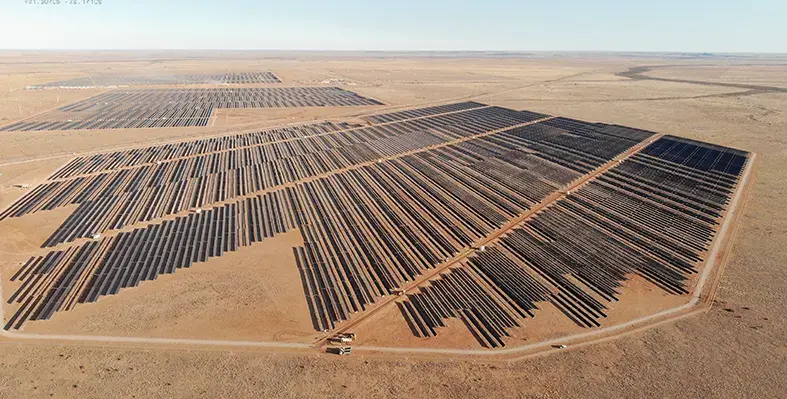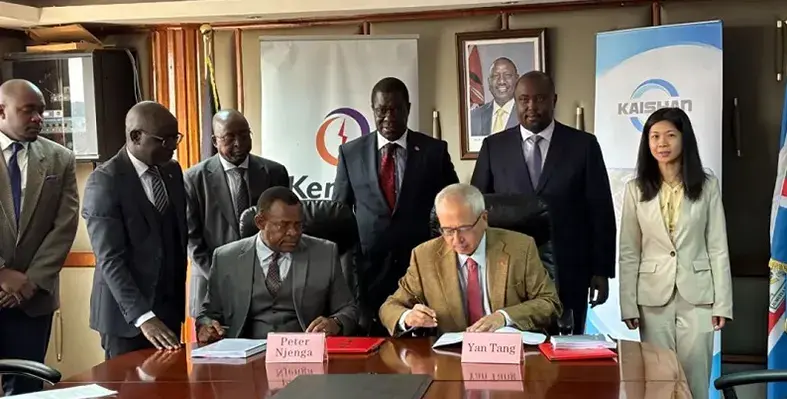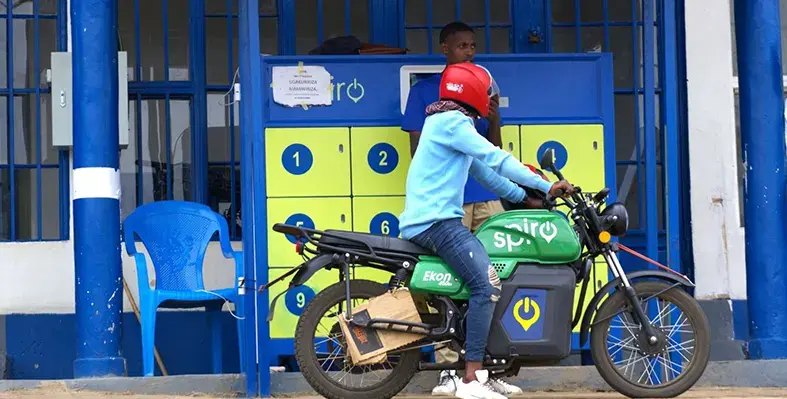
Scatec’s Kenhardt hybrid solar and battery project in South Africa recognised among top six global energy initiatives. (Image source: Scatec)

Scatec’s Kenhardt hybrid solar and battery project in South Africa recognised among top six global energy initiatives. (Image source: Scatec)

Kaishan Group partners with KenGen to develop a 165 MW geothermal plant powering Kenya’s green ammonia production. (Image source: Kaishan Group)
Kaishan Group has entered into a landmark partnership with Kenya Electricity Generating Company (KenGen) to advance the country’s renewable energy capacity through a 165 MW geothermal power project
The agreement marks a major step toward Kenya’s ambition to lead Africa in clean energy and green industrial production.
On October 27, a Steam Supply Agreement was signed at the Ministry of Energy of the Republic of Kenya by Tang Yan, managing director of Kaishan Group Co., Ltd., and Eng. Peter Njenga, general manager and CEO of KenGen. The signing ceremony was witnessed by Opiyo Wandayi, EGH, minister of energy of the Republic of Kenya.
Under the terms of the agreement, KenGen will utilise its existing geothermal wells to supply steam sufficient to produce 165.4 MW of electricity to Kaishan Terra Green Ammonia Limited (Kenya), a wholly-owned subsidiary of Kaishan. The company will build a geothermal power plant to generate electricity that will be used to produce 100,000 tons per year of green ammonia and green fertiliser.
The US$800mn project will yield 200,000 tons of green ammonia, 180,000 tons of urea, and 300,000 tons of calcium ammonium nitrate annually, all produced using green ammonia as the raw material. Once operational, the facility is expected to generate annual revenue of US$220–250mn, according to company announcements.
“This is another significant milestone for our group in its transformation and upgrading process, following the successful construction of the SMGP geothermal power plant (annual revenue of US$120–150mn),” Kaishan Group stated. “The global energy transition has entered a green energy era centered on hydrogen. Previously, our group identified ‘a globally important participant in the development and operation of green hydrogen and ammonia’ as one of our three major visions. It is anticipated that once the Kenya green ammonia project is completed and put into operation, our group will also become a leading force in the development and operation of green hydrogen and ammonia.”
The company highlighted that while many projects rely on solar and wind energy to produce hydrogen and green ammonia, few have been successfully launched due to the intermittent nature of solar and wind power and the high cost of energy storage. In contrast, geothermal energy provides stable, continuous baseload electricity, eliminating the need for storage facilities.
Kaishan noted, “Once the technology for producing green ammonia through the combination of geothermal power with wind and solar power is validated, Kaishan's innovative technology will open another important channel for global hydrogen energy development and is expected to pave a bright future for Kaishan Group's transformation into a great new energy company.”
Before the signing ceremony, Minister J. Opiyo Wandayi met with representatives from both Kaishan Group and KenGen to discuss the project’s strategic significance for Kenya’s renewable energy and industrial sectors.

Riders are rapidly shifting from internal combustion motorcycles to Spiro’s more affordable and accessible battery-swapping ecosystem and motorcycles. (Image source: Spiro)
Spiro, Africa’s leader in two-wheel transportation and battery swapping, has announced a landmark US$100mn investment round, the largest in the continent’s two-wheel electric mobility sector to date
The round includes US$75mn from The Fund for Export Development in Africa (FEDA), the development impact investment arm of the African Export-Import Bank (Afreximbank). This investment reinforces Spiro’s mission to make mobility more affordable and accessible while transforming Africa’s clean energy and urban transport sectors.
“Africa is at an inflection point in personal mobility. Riders are rapidly shifting from internal combustion motorcycles to Spiro’s more affordable and accessible battery-swapping ecosystem and motorcycles. For the first time, riders are embracing sustainable transportation because it performs better, costs less to operate, and offers greater profitability than traditional gas-powered vehicles,” said Kaushik Burman, CEO of Spiro.
“This landmark US$100mn investment underscores our shared vision to build a pan-African battery-swapping infrastructure that empowers riders with reliable, sustainable energy and mobility across the continent."
Spiro plans to use the funding to expand its industry-leading battery-swapping infrastructure in both existing and new markets while enhancing its technology platform. The company aims to surpass 100,000 deployed vehicles by the end of 2025, solidifying its leadership in Africa and placing it among the world’s foremost battery-swapping providers.
“We are delighted to partner with Spiro on this transformative initiative. Our investment reflects Afreximbank’s strong commitment to building a competitive and sustainable mobility sector in Africa,” said professor Benedict Oramah, president of Afreximbank, and chairman of the boards of directors of Afreximbank and FEDA.
“Together, we are laying the groundwork for a new era of intra-African trade and industrialisation by stimulating local vehicle manufacturing, strengthening regional integration, and enhancing trade flows. At the same time, we are focused on creating skilled employment opportunities and reducing the continent’s reliance on imported second-hand vehicles.”
Spiro aims to revolutionise Africa’s transport ecosystem through advanced battery-swapping technology and accessible electric motorcycles. With a strong commitment to “made in Africa, by Africans for Africa and the world,” Spiro operates the continent’s largest and fastest-growing battery-swapping network across Kenya, Uganda, Rwanda, Nigeria, Benin, and Togo, with pilot programs in Tanzania and Cameroon. Before this round, Spiro had secured over US$180mn from Equitane and Société Générale.
“We are proud to welcome FEDA as a strategic investor as we accelerate the growth of Spiro’s mission to transform mobility, energy storage, and distribution across Africa,” said Gagan Gupta, Founder of Spiro. “Spiro’s rapid expansion into new markets reflects the continent’s strong appetite for clean, affordable, and efficient transportation. As we expand our battery-swapping infrastructure and integrate renewable energy sources into our energy mix, we are positioned to unlock substantial upside in Spiro’s energy distribution.”
“Spiro’s success to date is a clear demonstration of the strength and scalability of its business model,” said Marlene Ngoyi, CEO of FEDA. “The company’s rapid growth and strong market adoption underscore the significant demand for affordable, sustainable mobility solutions across Africa. With its integrated approach, Spiro has built a platform that is both commercially viable and socially impactful.”
South Africa-based Inspired Evolution has been named investment manager for Zafiri, a new entity focused on expanding access to electricity across sub-Saharan Africa
Zafiri is a capital investment vehicle to be established under the African Development Bank’s Mission 300 agenda to expand energy access for 300 million Africans by 2030.
Its founding partners also include the World Bank’s IFC, The Rockefeller Foundation, Trade and Development Bank Group and Nordic Development Fund.
Backed by an initial US$300mn capitalisation by 2026, Zafiri is expected to scale up to US$1bn to accelerate energy access in Africa.
Over its lifespan, it aims to facilitate new electricity connections and clean cooking access for more than 30 million people while supporting the growth of Africa’s distributed renewable energy (DRE) sector.
Operations will commence in early 2026.
“We are honoured to partner with IFC, AfDB and global investors to manage Zafiri, a vehicle uniquely designed to close the equity financing gap for distributed energy solutions across Africa,” said Wayne Keast, co-founder and managing partner at Inspired Evolution.
“We will focus on building and scaling high-impact businesses that can deliver clean, affordable and reliable energy while driving inclusive and climate-resilient economic growth.”
Zafiri’s goal is to channel long-term equity into DRE companies that are deemed essential to last-mile access, yet remain underfinanced by mainstream capital markets.
Announcing the appointment of Inspired Evolution to lead the project, Ethiopis Tafara, IFC’s vice president for Africa, said the lack of equity financing for distributed energy companies remains one of the key challenges slowing the continent’s energy transition.
“Zafiri addresses this ‘missing middle’ by offering long-term equity to these providers, helping scale innovative business models,” said Tafara.
Inspired Evolution brings strong local investment expertise and a proven track record, making it a valuable partner for M300 in delivering development impact through the private sector, Tafara added.
Founded in 2007, the climate investment firm also has offices in Nairobi, Abidjan, London and Mauritius.
Headquartered in Cape Town, it has financed more than 10 GW of renewable energy generation, supported 29 companies across 18 African countries, and manages over US$850mn, including co-investments, through its suite of Evolution funds.
Kevin Kariuki, AfDB’s vice president for power, energy, climate and green growth, said that Zafiri will “inject the much-needed risk capital to take the DRE sector to the next level in terms of commercial maturity, larger operational footprint, and ultimately impact on the many communities beyond the grid.”
Read more:
Renewable energy boost for African mining
Sterling and Wilson Renewable Energy Limited (SWREL), a leading domestic renewable EPC, has announced that it has secured three new projects
The company has been declared L1 for the Engineering, Procurement, and Construction of a 363 MWp DC PV plant in Rajasthan, India (approx. US$430mn).
Additionally, SWREL has been declared L1 for the Engineering, Procurement, and Construction of a 580 MWp DC PV plant in Uttar Pradesh, India (approx. US$690mn). Both domestic orders are on a BOS basis.
The company has also received a Letter of Intent (LOI) for a 115 MWp project in South Africa, valued at approximately US$120mn.
The combined EPC value of these three new orders is approximately INR 1,772 crore (approx. US$1.24bn), bringing total order inflows for this fiscal year to INR 3,775 crore (approx. US$2.64bn).
Speaking on the order wins, Chandra Kishore Thakur, global CEO, Sterling and Wilson Renewable Energy Limited, said, “We are very happy to have won two more prestigious domestic solar projects and these project wins continue to reflect our strong positioning in a fast growing domestic market. Apart from our leading presence in India, we are also encouraged by the strong inroads we are making into another rapidly growing market in South Africa where we have bagged our third order worth USD 120 million. Our earlier two projects in South Africa are progressing well. We will be completing the projects in Q1 FY2027 and will be maintaining our order booking margins.”